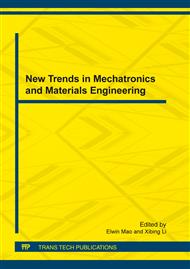[1]
L. L. Hench, H. A. Paschall, Direct chemical bonding between bioactive glass-ceramics materials and bone, J. Biomed. Mater. Res. Symp., 1973, 4: 25-42.
DOI: 10.1002/jbm.820070304
Google Scholar
[2]
L. L. Hench, Bioceramics: A clinical success. Am. Ceram. Soc. Bull., 1998, 81: 67-74.
Google Scholar
[3]
William Lai, Jonathan Garino, Paul Ducheyne. Silicon excretion from bioactive glass implanted in rabbit bone. Biomaterials, 2002, 23: 213-217.
DOI: 10.1016/s0142-9612(01)00097-7
Google Scholar
[4]
Fuxi Gan, Modern science and technology of glasses. Shanghai Science and Technology Publishing House, shanghai, China. 1990, 281-290.
Google Scholar
[5]
Moussa Hamadouche, Alain Meunier, David C, Greenspan et al. Long-term in vivo bioactivity and degradability of bulk sol-gel bioactive glasses. J Biome Mater Res, 2001, 54: 560-566.
DOI: 10.1002/1097-4636(20010315)54:4<560::aid-jbm130>3.0.co;2-j
Google Scholar
[6]
Kai Zhang, Hongwei Yan, David C. Bell et al., Effect of materials parameters on mineralization and degradation of sol-gel bioactive glass with 3D-ordered macroporous structures. J Biomed Mater Res, 2003, 66A: 860-869.
DOI: 10.1002/jbm.a.10093
Google Scholar
[7]
M. Vellet-Regi, A. J. Salinas, J. Roman et al., Effect of magnesium content on the in vitro bioactivity of CaO-MgO-SiO2-P2O5 sol-gel glasses. J. Mater. Chem, 1999, 9: 515-518.
DOI: 10.1039/a808679f
Google Scholar
[8]
J. M. Oliveira, R. N. Correia, M. H. Fernandes, Effects of Si speciation on the vivo bioactivity of glasses. Biomaterials, 2002, 23: 371-379.
DOI: 10.1016/s0142-9612(01)00115-6
Google Scholar
[9]
E. Jallot, Role of magnesium during spontaneous formation of a calcium phosphate layer at the periphery of a bioactive glass coating doped with MgO. Applied Surface Science, 2003, 211: 89-95.
DOI: 10.1016/s0169-4332(03)00179-x
Google Scholar
[10]
A.G. Dias, M. A. Lopes, I. R. Gibson, J. D. Santos. In vivo degradation studies of calcium phosphate glass ceramics prepared by controlled crystallization. Journal of non-crystalline solids, 2003, 330: 81-89.
DOI: 10.1016/j.jnoncrysol.2003.08.056
Google Scholar
[11]
Hongwei Yan, Christopher F. Blanford, Brian T Holland et al, A chemical synthesis of periodic macro-porous NiO and metallic Ni. Adv. Mater, 1999, 11(12): 1003-1006.
DOI: 10.1002/(sici)1521-4095(199908)11:12<1003::aid-adma1003>3.0.co;2-k
Google Scholar
[12]
Wanpeng Cao, Larry L. Hench, Bioactive materials. Ceramics international, 1996, 22: 493-507.
Google Scholar
[13]
Jipin Zhong, David C. Greenspan, Processing and properties of sol-gel bioactive glasses. J Boimed Mater Res (Appl Biomater), 2000, 53: 694-701.
DOI: 10.1002/1097-4636(2000)53:6<694::aid-jbm12>3.0.co;2-6
Google Scholar
[14]
Oscar Peitl, Edgar Dutra Zanotto, Larry L. Hench, Highly bioactive P2O5-Na2O-CaO-SiO2 glass ceramics. Journal of noncrystalline solids, 2001, 292: 115-126.
DOI: 10.1016/s0022-3093(01)00822-5
Google Scholar
[15]
Aldo R. Boccaccini, Veronique Maquet, Bioresorbable and bioactive polymer/bio/glass composite with tailored pore structure for tissue engineering applications. Composite science and technology, 2003, 63: 2417-2429.
DOI: 10.1016/s0266-3538(03)00275-6
Google Scholar
[16]
S. Radin, P. Ducheyne, T. Kamplain et al., Silica sol-gel for the controlled release of antibiotics. I. Synthesis, characterization, and in vitro release. J Biomed Mater Res, 2001, 57(3): 313-320.
DOI: 10.1002/1097-4636(200111)57:2<313::aid-jbm1173>3.0.co;2-e
Google Scholar
[17]
Radin Shular, Gehan El-Bassyouni, Edward J. Vresilovic, et al,In vivo tissue response to resorbable silica xerogels as controlled-release materials. Biomaterials, 2005, 26(5): 10431052.
DOI: 10.1016/j.biomaterials.2004.04.004
Google Scholar
[18]
Xiaokai Zhang, Xiaofeng Chen, Yingjun Wang, et al. Acta Chimica Sinica, 2005, 63(22): 2077-(2081).
Google Scholar
[19]
Priya Saravanapavan, Larry L. Hench, Mesoporous calcium silicate glasses. Ⅰ. synthesis. Journal of non-crystalline solids, 2003, 318: 1-13.
DOI: 10.1016/s0022-3093(02)01864-1
Google Scholar
[20]
PanJian Li and Feipeng Zhang, The electrochemistry of a glass surface and its application to bioactive glass in solution. Journal of Non-Crystalline Solids 119(1990)112-118.
DOI: 10.1016/0022-3093(90)90247-j
Google Scholar
[21]
Patricia Valerio, Marivalda M. Perira, Alfredo M. Goes, et al., The effect of ionic products from bioactive glass dissolution on osteoblast proliferation and collagen production. Biomareials,2004, 25: 2941-2948.
DOI: 10.1016/j.biomaterials.2003.09.086
Google Scholar
[22]
P. Sepulveda, J.R. Jones, L.L. Hench. In vivo dissolution of melt-derived 45S5 and sol-gel derived 58S bioactive glasses. J Biomed Mater Res. 2002, 61: 301-311.
DOI: 10.1002/jbm.10207
Google Scholar


